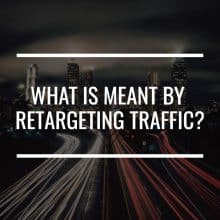

Have you ever noticed advertisements popping up everywhere for a particular product after searching for it on Amazon? You probably didn’t realize that you’re being “retargeted.” The purpose of a retargeting campaign is to remind website visitors of products and services after they leave without buying.
Retargeting campaigns allow you to retarget visitors to your website by showing them relevant visual or text ads when they visit other websites after they’ve visited a specific page on your site. Retargeting campaigns could be done with the help of Google Ads, Facebook retargeting, AdRoll, and other retargeting advertising platforms.
Plenty of today’s internet marketers consider retargeting a “must-have” tool to connect with customers and increase sales and customer loyalty.
Visitors who have browsed your site in the past will start to see your ads while reading articles on other sites, listening to music, or while browsing other online stores. Your ads will remind them of what you have to offer and (hopefully) bring them back to your site.
Diving into the technical-side of things, retargeting occurs when you place an unobtrusive piece of code on your website (sometimes referred to as a pixel or a cookie) to anonymously follow your visitors once they exit your website.
The pixel is unnoticeable to your website’s visitors and won’t affect them nor your website’s performance. The cookie will let your retargeting provider know when to serve ads, ensuring that your ads are served only to people who have previously visited your site.
In just a few clicks, you can automate ads that recapture sales in the background. This allows you to focus on other important parts of your business.
Retargeting campaigns have two goals: awareness and conversion. Awareness campaigns are less-popular while conversion campaigns are more sought after.
Awareness campaigns are commonly used to inform former website visitors about your product features and major announcements. These campaigns are less common because it’s directed at visitors who haven’t interacted a lot with your website. However, awareness campaigns can be run as preparation for a conversion campaign.
Conversion campaigns, on the other hand, focus on visitors who are familiar with your brand, products, or services, but who still haven’t committed to an offer. They just need a little push to convert. Retarget these visitors with an ad that directs them to a post-click landing page that persuades them to convert.
Retargeting is a smart way to convert an already interested shopper. Whether they were just visiting your site or have actually put an item in the cart, these people have shown genuine interest in your products.
The effort it will take to win them over again is much less than someone who’s never been to your site before. A smart retargeting campaign can help you reach these former visitors at the right time with the right product for maximum sales and profits.
Retargeting reinforces and reminds.
It reminds people of your brand, even after leaving your website. It’ll continually establish your presence. Combined with email marketing, the use of retargeting ads will drastically improve the chances of converting a visitor.
I've been in internet marketing for over 10 years, and I've purchased dozens of illegitimate products for the sole purpose of evaluating them and exposing the truth about these products to anyone who's thinking about purchasing it. I never let money influence my rating of a product and your success/safety is my absolute highest priority. Don't want to buy a product? Register for one of my 100% free internet marketing training courses>>